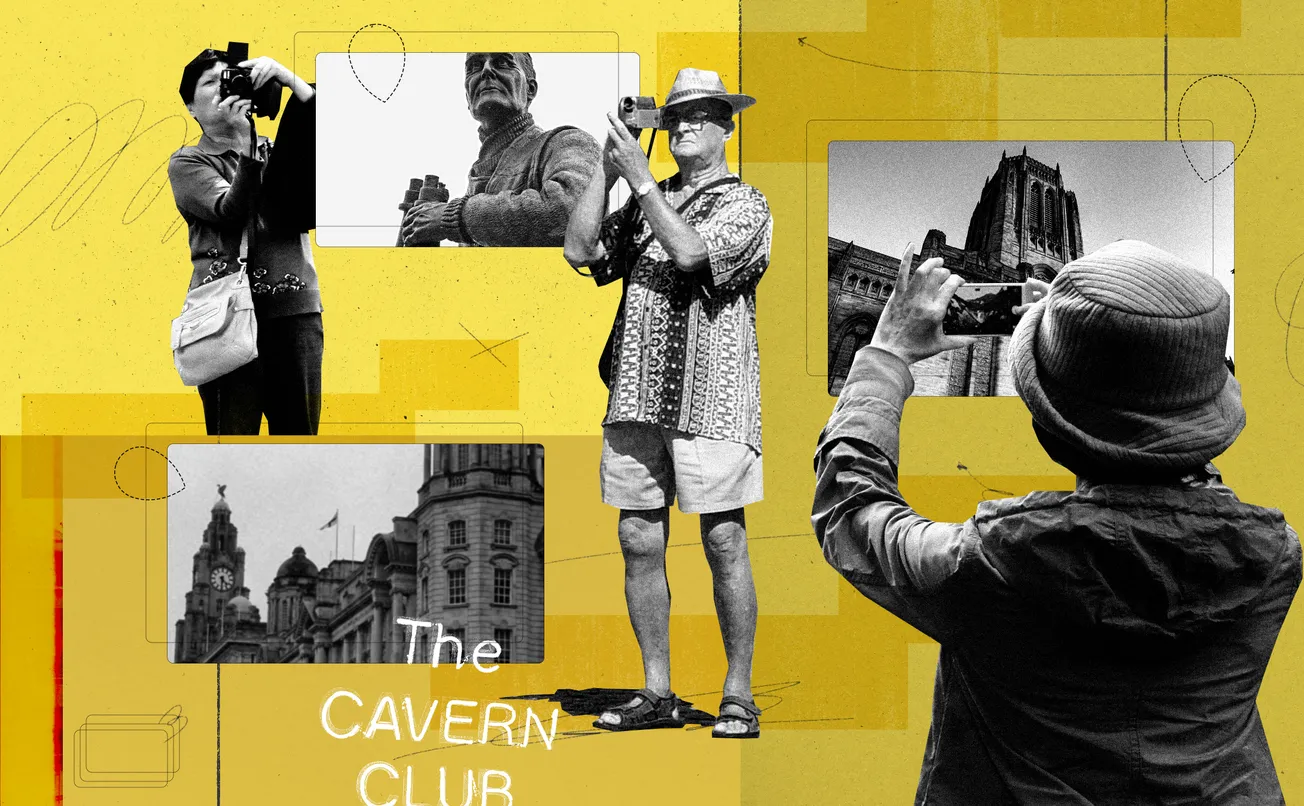Tourism is worth £6 billion to the city region. Are visitors getting their money’s worth?

We cruise around Liverpool with intrepid travellers from far-off (and not-so-distant) lands
By the time I get down to Princes Dock, the May sun is already threatening to turn the whole of Pier Head into some kind of hazy Mediterranean port. Hoping – perhaps quixotically – to see the city afresh through the eyes of disembarking tourists, I had meant to be at the terminal when the cruise ship Ambition first docked, but a broken-down bus waylaid me. Now, the roughly Titanic-size Ambassador vessel has been idling for a good hour off Princes Parade, sunning itself like a 48,000 gross-tonne whale, its passengers spreading out across the Strand and into the city.
Liverpool regularly ranks in the top five most visited cities in the UK. According to LCRCA, around 60 million people pop in per year — as that’s around 10 million more than Paris received the year it hosted the 2024 Olympic games, I’m curious what metric the mayor’s office is using. Regardless, they say it’s worth about £6 billion to a visitor economy that employs more than 73,000 locals. We’re told it’s the most-filmed city outside of London, which may be a double-edged sword given how many of them seem to be about gangs, drugs, and crime – but it doesn’t seem to have done much harm so far. Head to Reddit and you’ll encounter all kinds of delighted holidaymakers: “I will 100% be bringing the family here again. The culture, people and city was the most welcoming I've ever felt in all of the UK,” writes American tourist 10CansOfBounceDatAzz. (A vast improvement over a now infamous TripAdvisor review from one freddietexan, whose 30th wedding anniversary was ruined when “a man dressed as an adult baby called my wife a ‘Mad yank slut’ because she’d never heard of a band called Steps.”) Last year, Liverpool topped a Which? Travel poll of 4,000 members as the UK’s best large city break, with the magazine’s editor citing our “vibrant nightlife”, “world-class museums”, and “buzzing atmosphere”.
High praise. But these are the kind of words that cluster together like fluff and wool: they’re not quite clichés, but they make writers want to reach for a lint roller. (Has a city’s nightlife ever been praised for being anything other than “vibrant”?) So I set out to speak to the tourists themselves and see what really brings them here.
Some of Ambition’s passengers are clustering around Canada Boulevard, suitcases firmly parked, availing themselves of the wide concrete seat-steps or the green space around the canal link. I wonder why they’re not living up to their ship’s sobriquet and venturing into the city. A man in a sunhat and shades tells me Liverpool has “a reputation, doesn’t it?” (when asked, he doesn’t elaborate — perhaps he’s a BBC drama enthusiast); a woman tells me she’s “not a Beatles fan”. Some only got off the Ambition to “stretch their legs” and are happy to wait around the dock area until the 500 bus stops at Paradise Street to take them to John Lennon Airport.
But these timid cruisers seem to be the minority. Along George Parade the atmosphere is, indeed, buzzier – skateboards clack, seagulls squawk, an enterprising busker croons “Norwegian Wood” next to the Beatles statue. Maybe it’s the songs or maybe it’s the sun, but the Fab Four statue itself is doing good business. I hear American voices, Eastern European accents and the French language in the queue for selfies. One woman with a front-wheeled walker, irritated by her photo being rushed, shouts, “I saw them live in 1963!”
In the shadow of the Cunard Building, I meet Annie and Neil, a couple from Fife. They’re actually not Ambition passengers but are due to take a Fred Olsen cruise tomorrow. They’re waiting for the city tour bus.
“We’ve learned the trick of coming down a day early so we can see more,” Annie says, before extolling the virtues of Liverpool. Last time they were here, they went on the Magical Mystery Tour and saw a rock concert at the Philharmonic. I ask if there’s anything about the city they’re dissatisfied with.
“Absolutely nothing!” Annie says. “What’s on offer is amazing.” As Neil goes to take a picture of the nearest of the Three Graces, Annie does reflect on the homelessness she’s seen, but adds that’s a problem everywhere.
At Liverpool One, I do catch up with some of the Ambition’s passengers – six women gathered around the You Are Here map on South John Street. As they’re laden with suitcases, I help the ladies navigate the various lifts and escalators up to the restaurants on the top level, only getting them lost once.
“We’re from Belfast,” Denise tells me. (“Not all of us,” Lynn corrects her – some are from “just outside.”) We’re sat outside Slim Chickens overlooking Chavasse Park. A mild sea breeze now complements the sunshine. I ask what brings them to Liverpool. It’s just the last stop of a cruise that’s taken them to Honfleur, Zeebrugge, and IJmuiden – they’re flying back to Belfast in the evening.
“But Liverpool’s OK,” Ann says. “We know it’s a safe city.” Ann’s son studied in Liverpool and now teaches at John Moores, while her daughter runs a B&B in Belfast that receives a lot of Liverpudlian custom. Lynn’s son has a girlfriend who lives near Anfield.
We talk for a while about the shared heritage between the two cities, both positive and negative, and how reputations can be hard to shake off. It’s clear there’s a sense of mutual identification. (Belfast, incidentally, came second in the Which? survey, with 77% positive score just behind Liverpool’s 84%.) The girls are also keen for me to know the Titanic was built in Belfast.
As for the specifics, the ladies are impressed with how accessible Liverpool is, especially Liverpool One’s proximity to the ferry dock. Denise, who went on a walking tour of the city last time, was also here in the 1980s. “It wasn’t much more than the two cathedrals then,” she says. “But there’s much more to see now.”
“It’s so clean,” agrees Janice, something that may come as a pleasant surprise to some readers.
Lynn has suffered some disappointments, though. At the Albert Dock – which otherwise comes in for praise – the ladies found the Tate Liverpool closed. Despite Tate's original 2025 target, the gallery is now working towards reopening in 2027, by which time it will have been shuttered for half a decade.
The Belfast contingent then tried to visit the International Slavery and Maritime museums, only to find those shut too – until 2028, as things stand. I mention the World Museum and Walker Art Gallery, but with suitcases such a sojourn will likely take the Speke-bound tourists too far from their Paradise Street departure point. I’m not a representative of Tate, National Museums Liverpool or the tourist board, and do recognise that institutions do need refurbishments from time to time, but I also feel vaguely embarrassed by our “world-class” museums all being closed at once.
Leaving my new friends in Liverpool One, I venture up towards a tourist hotspot I’d been dreading. In a recent article, I half-jokingly suggested Mathew Street should be filled in with concrete. But there’s little point in denying what the queue before the Pier Head statue earlier only hinted at: as a cultural node, the Fab Four are by some way the biggest attraction the city boasts. Indeed, it’s not until I get there that I realise so much of the surrounding streets are just an irrelevance to certain visitors.
“The Beatles, definitely,” says Betina when I ask her whether she and her partner are here for the city, or the band. “Although, it’s more for him than me.” She nods at June, who is gazing with wide-eyed astonishment at the Cavern Club entrance. I don’t have the heart to mention this is just a replica of the club The Beatles played at: they’re both lovely and they’ve come all the way from LA, after all.
Outside The Grapes pub, where Pete Best went to drown his sorrows after being kicked out of The Beatles, “Check” by FLO is competing with a nearby circular saw to see which can reach the 100-decibel mark first. When I can once again hear myself think, I wonder if hitching the city’s wagon to musicians from sixty years ago is a sustainable model – I somehow doubt Mahler and Schoenberg held equivalent sway over artistic horizons in the 1960s. Can we always rely on John, Paul, George and Ringo to bring in the punters?
Apparently so. Wandering back down towards the Mersey, I meet three young people queuing for the Magical Mystery Tour bus at Salthouse Quay. Harry, 23 years old in a psychedelic Paul McCartney tour shirt, has made the holy pilgrimage to Liverpool before, and this time convinced his friends Aime and Storm – also both 23 – to accompany him on a day trip from Norfolk. Neither of the girls are Beatles fanatics but are impressed on their first visit to the city. Aime tells me after the two-hour Mystery Tour they intend to hang out in book shops before returning to their accommodation near Blackpool.
I also run into Betina and June again, queuing for the Beatles-themed bus which will take them past John Lennon’s childhood home on Menlove Avenue and George Harrison’s birthplace of Arnold Grove. June is astonished and a little perplexed I’ve never taken the tour, which I suppose must be like a Parisian confessing they’ve yet to venture inside Notre Dame, an acrophobic New Yorker, or a Mancunian admitting they’ve at no time been even a little bit madferit. Although I’m briefly tempted, my severe autoimmune response to Sixties nostalgia suddenly flares up and precludes me from accompanying my new friends.
Nonetheless, seeing the city from a fresh perspective has added a sheen of unfamiliarity after all. At a few paces back, Liverpool’s coastal position, classical architecture, and cultural capital are a peculiar mix that’s easy for locals to take for granted. Unfortunately, the UK’s astronomical rail fares and lopsided emphasis on London will likely hobble the city from joining the élite of non-capital European city destinations, but its current status is nothing to be sniffed at.
With three hours until sundown, my trust in Arriva temporarily shattered, and still nursing a two-day hangover from my own “vibrant” weekend, I decide to eschew our vaunted nightlife. (I did consider writing about that, but I don’t think Shenanigans on Tithebarn Street or the Lady of Mann courtyard are typical tourist fare.) Instead, I take Aime’s recommendation and head towards the “absolutely amazing” Rough Hand Made bakery on the Albert Dock. Okay, I’ve been here plenty of times before, but I can’t resist treating myself to a cream cheese and blueberry pasty about the same heft of a cruise ship. If that’s not worth visiting Liverpool for, nothing is.
Thanks for reading my story today. I’d love to hear your thoughts on tourism in Liverpool, and what hotspots I might have missed out on. Please click that comment button to join the conversation under the article, and have a fantastic weekend.

Comments
Latest
I’m calling a truce. It’s time to stop the flouncing
The carnival queens of Toxteth
The watcher of Hilbre Island
A blow for the Eldonians: ‘They rubber-stamped the very system they said was broken’
Tourism is worth £6 billion to the city region. Are visitors getting their money’s worth?
We cruise around Liverpool with intrepid travellers from far-off (and not-so-distant) lands